She’s Not Like All the Other Girls
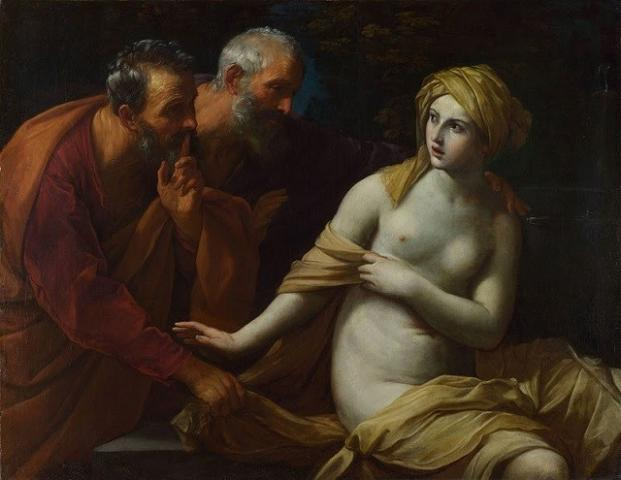 Guido Reni, "Susannah and the Elders", c. 1620.
Guido Reni, "Susannah and the Elders", c. 1620.
di Sam Vladimirsky
Guido Reni era sfortunato al gioco, ma non perché fortunato in amore. L’amore non faceva parte del repertorio della sua vita. Nessuno lo aveva mai visto con una donna. Era vergine. Molti lo paragonavano a un angelo. Amore per lui era solo un puttino biondo. Grazioso e perfetto come chi esiste solo nei sogni.
Se era sfortunato, è perché doveva continuare a dipingere. Infatti, se avesse vinto ogni sera, non avrebbe più avuto bisogno della pittura né di dipingere donne. scrive il biografo di Reni Richard Spear, "non poteva sopportare di avere donne intorno a sé"
Guido Reni cercò in tutti i modi di non essere ricordato.
Guido Reni tried hard to be forgotten. The seventeenth century Bolognese painter spat on poetry that extolled his name, rejected all praise that did not concern his art, refused to send biographical details to a well-known artist biographer, kept letters from royalty unopened, and eventually left Rome as a knighthood was pending.
Once considered among the greatest artists of his time, Reni was ultimately abandoned by a Victorian public disinterested in all things Baroque art. His was a “middlebow” taste, or so it was thought. In 1954, Reni’s home city of Bologna organized an exhibition intended to re-introduce the shut-in painter as a “new artist”, who for too long had been the victim of three-hundred years of ignorant gibes.
In the years since, it has become clear that Reni was a deeply religious man with a complicated relationship to women, not unlike Mike Pence. “With the exception of his mother, to whom he was strongly attached,” writes Reni biographer Richard Spear, “he could could not stand having women around him.” A friend of the artist observed him turn “like marble” when he had to draw a female model from life, and he refused to be left alone with her. In another instance, the painter became outraged when a woman accidentally touched his laundry. Spear proposes that the anxiety-prone artist might have been living as a closeted gay man.
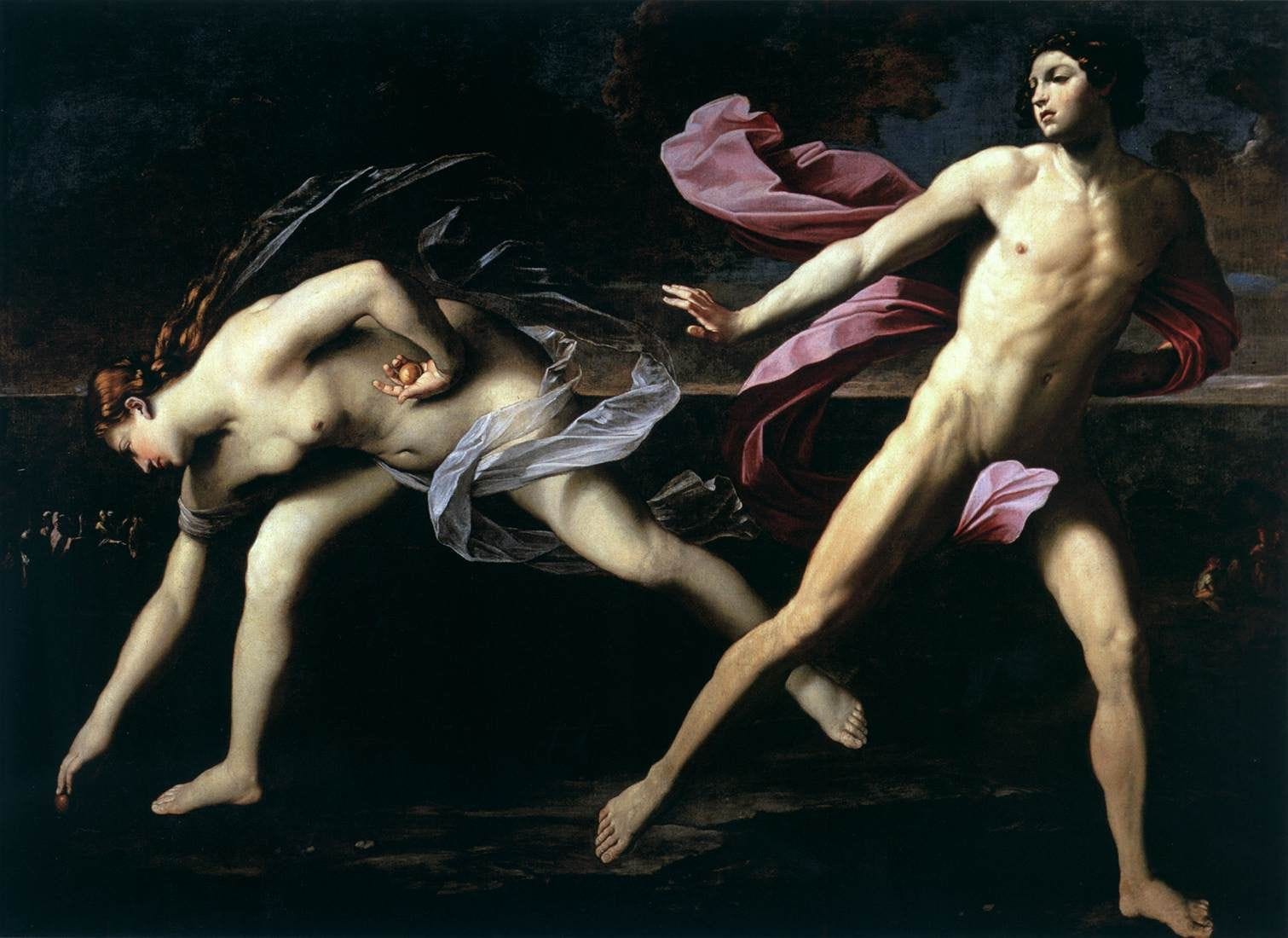 Guido Reni, Atalanta and Hippomenes, c.1620–25
Guido Reni, Atalanta and Hippomenes, c.1620–25
In his paintings, male characters reject their female counterparts, as though repulsed to see them in the nude (fig. 2). While men are often painted in nonviolent situations, his women characteristically find themselves in danger.
It is for this reason that I was surprised to discover his painting Susannah and the Elders in the National Gallery of Art, London (fig. 1) on a recent visit. His depiction of the scene struck me as unusually progressive for a bible verse that lent itself to centuries of the painted male gaze.
This is the case for Guido Reni
Reni was a gambler. By the 1630s, the esteemed Bolognese painter had run up insurmountable losses resulting in an accelerated work pace and the production of endless copies. But sometime between 1620 and 1625, Reni made a gamble of a different sort — intentionally or otherwise — in his unusual painting of Susannah and the Elders, an apocryphal addition to the Book of Daniel. The theme was a popular one among male painters because of the opportunity it presented to engage in a form of legitimized voyeurism: here was a chance to self-indulge in the erotic appeal of painting a Venus whose eroticism lies not only in being observed and exposed, but in the her half-hearted resistance to sexual temptation, heightened by the presence of two lecherous old men who attempt it. It was an authorization to look, to gaze, to want. In her essay “Artemisia and Susanna”, Mary Garrard observes that such treatments in paintings of Susannah were “iconographically justified and pornographically effective.”
Reni’s Susannah, however, betrays no intention to fall into this category. Although she inherits some of the Venus-like qualities of her sister Susannahs — a larger-than-life glow, idealized female curvature, with exposed breasts and a single kneecap coyly peeking out from beneath a sea of opaque ochre linen — in her response to the Elders’ sexual advances, this Susannah is anything but the ideal Renaissance woman as imagined by Tintoretto, Rembrandt, Rubens, or van Dyck: she proves herself a faithful wife of Joakim in her vigilant rejection of the lecherous judges, and in so doing, exceeds her status as a mere object of desire upon which the Elders prey.
What we witness in Reni’s painting is an unusually faithful representation of Susannah’s story from the Book of Daniel, achieved through a sequence of bodies in transformation, by which I mean changes from one state to another, actively taking place in the painting, implied to have already happened, or suggested will occur soon. In so doing, Reni’s Susannah and the Elders most closely honors the original story’s moral takeaway: that is, according to Garrard, “a contest between good and evil, virtue and vice, mediated by wise judgement” and informed by Susannah’s chastity. Contrary to her endless depictions in European painting throughout the sixteenth through eighteenth centuries as merely the end goal of the Elders’ erotic escapades, Susannah was never tempted by her would-be assailants.
Per Renaissance and Baroque convention, most Susannahs were painted by men with misinformed understandings of the story; it is a testament to the indomitable male ego, Garrard argues, that a bible story about female chastity was polluted into a celebration of sexual opportunity. Susannah’s dilemma was never whether or not to sleep with the Elders. It was a question of fidelity to her husband Joakim that would test her moral backbone and sense of judgement, at the risk of her own life, which, in what could have been its final hour, is saved by Daniel: divine justice manifest. The good wife prevails. (Unsurprisingly, paintings of Susannah and the Elders were not uncommon wedding presents.)
It is worth taking a look at Reni’s highly underrated Susannah through three themes: chastity (the intended moral of the story, in which transformations of the body make Susannah unavailable to the Elders) as well as seduction and shame (the lens through which countless male artists have interpreted the passage, in which transformations concern the sense of sight.) But first, it is necessary to identify some of the transformations with which we are dealing.
Susannah, Transformed
Perhaps the most significant is one that we seem to have just missed, one invisible in the painting yet implicitly, almost forcefully present — it is, of course, the scene’s defining transition from private to public. Like many of the other transformations, this shift works two ways: the Elders emerge from some distant shrubbery, thus revealing their voyeurism by literally bringing it to light; consequently, Susannah’s privacy is compromised, and she too enters the public sphere.
Witness two other dual transformations, particularly affected by the sensation of touch: first, the simultaneous covering up and disrobing that is taking place, an active tug-of-war between the seers and the seen, between modesty and shame — Susannah’s desire to conceal her nakedness pitted against the leftmost Elder’s efforts to reverse the process. Second, observe the backmost Elder’s hand just beginning to grip Susannah’s shoulder, as her own hand moves to stop his accomplice from pulling at the linen with which she hopes to preserve her modesty. Reni takes us mid-transformation from untouched to touched; in just a second, the Elder’s remaining three fingers will find their way onto Susannah’s skin just as her hand will grab the red-robed wrist of his accomplice. This battle of wills is playing out the longer we look at the painting.
These action-reaction gestures on the part of Susannah and her would-be assailants set in motion a series of transformations, inevitably suspended (an unfortunate consequence of painting), that contribute to this work’s unusual nature, for representations of this scene often show us either a Susannah who has just covered herself, or Elders who have not yet disrobed her. In other words, most paintings of Susannah and the Elders show us the moment just before or immediately after sexual harassment.
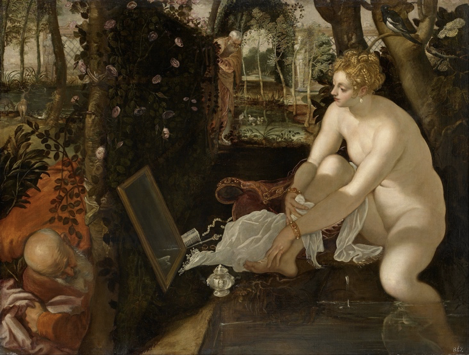 Jacopo Robusti, called Tintoretto, Susanna and the Elders, 1555–56
Jacopo Robusti, called Tintoretto, Susanna and the Elders, 1555–56
Tintoretto’s interpretation from the mid-16th century (fig. 3) occurs before the Elders reveal themselves. Robert Hahn argues that rather than focus on the active transformations apparent in Reni’s painting, Tintoretto’s is about a network of gazes (which I will return to later in this paper): it is “a compounding of contiguous instants” before the Elders attempt to seduce Susannah, where “stopped-time becomes a space where the eye can move about freely.”
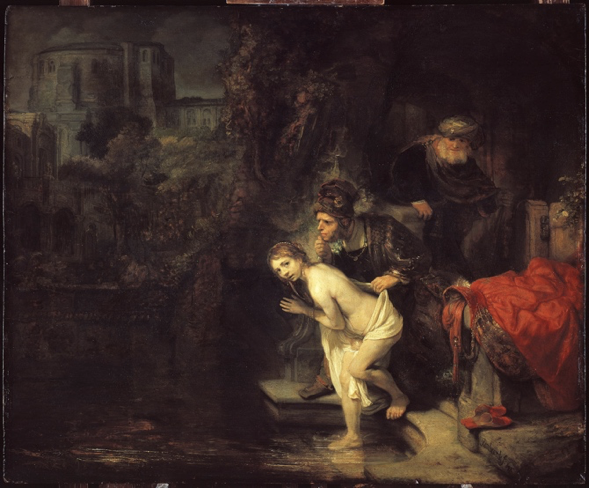 Rembrandt, Susanna and the Elders, 1647.
Rembrandt, Susanna and the Elders, 1647.
In Rembrandt’s 1647 version (fig. 4), Susannah — one foot already in the water — is a fraction of a second away from detecting an Elder pulling at her robe. Or, perhaps she has just become aware of the Elders’ presence but has not yet taken action to turn away or cover herself up.
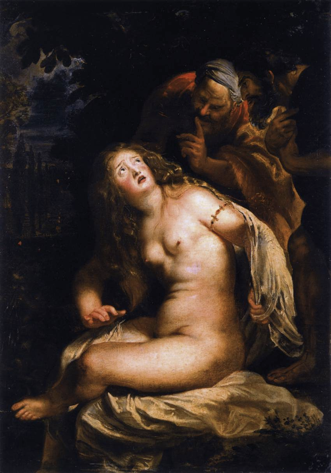 Peter Paul Rubens, Susanna and the Elders, 1607.
Peter Paul Rubens, Susanna and the Elders, 1607.
Peter Paul Rubens’s 1607 Susanna (fig. 5) is immediately alarmed when the Elders try to keep her quiet, but betrays no greater effort to cover herself up than does Tintoretto’s Susannah. Instead, we get a full display of “Susanna’s ethereal radiance, which we adore, and her alluring body, which we desire.” Reni’s Susannah, in stark contrast, is an active participant in the story that charts her fate, a rare biblical heroine, a virtuous, faithful, exemplary Israelite wife, who stands apart from her countless sister depictions of a voluptuous, glowing Venus. Let us then examine it through the theme of chastity.
Chastity: Susannah, Wife of Joakim
Although we do not know exactly for whom Reni’s painting was intended, other than that it hung in the Palazzo Lancellotti in Rome by 1640, paintings of Susannah and the Elders were often commissioned by private collectors as wedding gifts. In his essay “Expanding the Litany for Susannah and the Elders,” the art historian Edward Olszewski argues that such paintings reinforced for the new bride the moral lesson of chastity, and the lengths to which she was expected to go to defend her virtue. The painting would remind her that woman was made from — and for — man. “If intended for the wedding chamber,” he writes, then a depiction of a beautiful nude in a story about chastity “would offer physical stimulation for the groom and moral restraint for the bride.”
From its very first line, the story of Susannah designates her first and foremost as the marital property of Joakim, without ever mentioning her name. “There was a man living in Babylon whose name was Joakim” — first line; second line: “He married the daughter of Hiliah, named Susannah” who is characterized by her beauty (“a very beautiful woman”), devotion (“one who feared the Lord”) and righteous upbringing. To suggest that the story of Susannah and the Elders was one about seduction or temptation is to mischaracterize her on the false assumption that Susannah found the Elders as attractive as they found her. Garrard maintains that Susannah’s preference of death to dishonoring her husband paints a picture of a rather flat character, who “in the absoluteness of her resolve” upholds “her virtue and honesty.” Susannah’s is a story of chastity above all.
This is supported by Reni’s painting, in which Susannah’s chastity relies on her physically not being available to the Elders. Notice the stone bench on which she sits. It serves as one of the block-like elements Michael Fried determines to be “the decisive structural (and structuring) element in the painting.” It creates a schism between Susannah and the Elders, relegating them to the leftmost third of our field of vision, while bringing her closer to us (Fried notes that this creates the effect of “presence” on the gallery wall.) The distance that separates her from the lecherous judges is then accentuated by Susannah’s transforming body, similar to- though less theatrical than Rubens’s Susannah. “Her almost naked body appears to be contracting,” writes Alexander Kozin, “making itself smaller by crouching and bending, almost falling onto itself.” This transformation catalyzes the action: the turning of Susannah’s figure toward the viewer as she leans away from the judges forces the Elder in the foreground to have to extend his arm in order to clutch onto a handful of her drapery.
 Artemisia Gentileschi, Susanna and the Elders, 1610.
Artemisia Gentileschi, Susanna and the Elders, 1610.
Similarly, in Artemisia Gentileschi’s version from a decade prior (fig. 6), a stone balustrade separates Susannah from her voyeurs, rendering her unavailable. Gentileschi’s Susannah also arrives at a more convincing expression of anguish and horror, putting on a highly theatrical gesture of protest. Still, the artist knew her audience. While the Elders may be structurally divided from the object of their lust, they nevertheless manage to spill over the top of the balustrade, however awkwardly, only a moment away from laying their hands on the Venus-like Susannah, who is full-breasted and entirely nude, save for a swathe of baby blue fabric wrapped around her left thigh and tucked behind her. Though Gentileschi makes a play at conveying chastity through this block element, Reni’s Susannah achieves it much more fully.
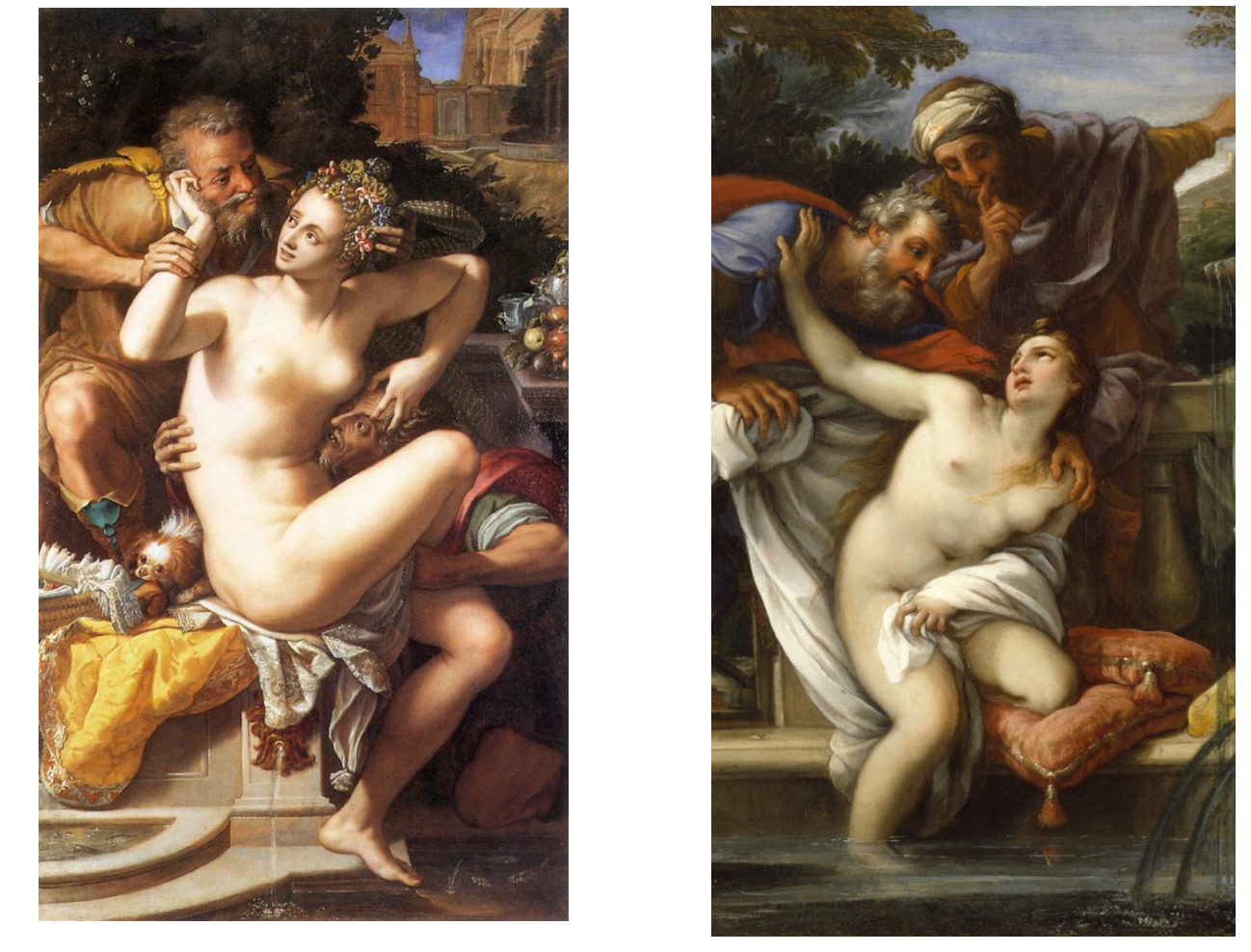 (left) Allesandro Allori, Susanna and the Elders, 1560/ (right) Giuseppe Bartolomeo Chiari, Susannah and the Elders [detail], c.1700–1727.
(left) Allesandro Allori, Susanna and the Elders, 1560/ (right) Giuseppe Bartolomeo Chiari, Susannah and the Elders [detail], c.1700–1727.
Nor does Reni’s Susannah betray any of the subtle acquiescence present in Alessandro Allori or Giuseppe Chiari’s takes of the same theme (fig. 7–8). Hunched over in a stock modesty gesture, Reni’s Susannah turns her body away toward the viewer, and cranes her neck to return the Elders’ longing gazes with one of striking knowing; she understands
her situation, and what must be done. The look transforms over time: it begins with surprise, her mouth slightly agape, she leans away from the two socially prominent bearded men; she has seen them before, acquaintances of her husband she once thought were supposed to be exemplary executors of the law. The look grows into trepidation, then evolves into concern, as one arm reaches for the linen to cover her exposed upper half, while the other gravitates toward the Elder eager to pull it out from under her; a second longer, and we might see her furrowing her brows. Finally, it concludes at moral rectitude: “I choose not to do it,” she says in the Book of Daniel, accepting her fate (death by stoning), “I will fall into your hands, rather than sin in the sight of the Lord.”
Another telling sign that Reni’s Susannah is unavailable to the Elders is her head covering, an element impossible to find in other versions of the scene, as long hair was used to accentuate an air of youth, sexuality and availability. The head wrap conceals, and is itself transformative in nature, beginning as a multipurpose piece of fabric before assuming its function. We can imagine Susannah wrapping it carefully around her head, layering it this way and that, before finally draping it across the right half of her visage. This gesture precedes the decisive “moment” of this painting, to borrow a photographic term, but can be interpreted as part of the larger sequence of Susannah covering herself with the ochre linen. The New Testament establishes that the pious woman who does not cover her head, particularly in prayer, disgraces herself. While man “ought not to have his head covered, since he is the image and glory of God,” the woman, made from man and for his sake, must conceal herself as “a symbol of authority on her head.” This was likely of personal importance to Reni, who was deeply religious verging on superstitious, devoted to the Virgin Mary, and attended church on a daily basis. Applying the words of the New Testament to this passage from the Old, Reni paints a Susannah that proves herself a devout wife, who, rightfully fearing the Lord, is not sexually available to the Elders, and is thus deserving of intervention from divine justice. “The Lord heard her cry.”
The closest we arrive to head covering in other interpretations of the scene, are versions in which Susannah’s hair is put up, but this is often an alluring element and a vehicle for sexual opportunity. Tintoretto painted Susannah’s hair in crisscrossed braids of golden locks interwoven atop her head, which uncurl at the forehead, and down her cheeks. To make up for not revealing the full volume of her hair, Susannah has not yet removed her gemmed bracelets and pearl earrings. In Allori’s sixteenth century version, Susannah’s hair is also put up, and decked out in pearls and ribbons. She is cradled between the Elders, playfully touching one, and allowing the other to nestle under her left breast with one arm around her waist, and the other reaching toward her genitals. What becomes clear, then, is that Reni did not meet the double standard for the Susannah figure in which gestures toward modesty also bore sexual connotations: “the requirement that Susanna be chaste, while appealing subliminally to the memory of the Venus archetype, whose gestures of modesty call attention to what she conceals.”
Seduction and Shame: Susannah Seen
Reading the story of Susannah and the Elders through the themes of seduction and shame is to read the story through transformations of sight, shifting networks of gazes between Susannah and the Elders, the painter, and the viewer. In Ways of Seeing, John Berger pinpoints the origins of painting nudes in European art to the story of Adam and Eve in the Book of Genesis. He underscores two striking facts: first, that the pair noticed they were naked not because they were, but as a result of eating an apple from the Tree of Knowledge. “Nakedness,” he writes, “was created in the mind of the beholder.” Similarly, twentieth century post-structural theory was built upon the idea that that which is visible has little to do with the sensory input of the eye. Although the (hi)stories we tell are grounded in “that determination of visible and articulable features” writes Gilles Deleuze in Foucault, they exist only because the observer has managed to invent them. Berger goes on to point out that in transforming the realm of the invisible to the visible, it was Eve who was blamed, punished, and made subservient to man. In Renaissance paintings of Genesis, her shame became the single moment depicted, “not so much in relation to [Adam] as to the spectator.” As Martha Hollander puts it, shame is a profoundly visible emotion that operates “across an interface involving seeing and being seen.” Seeing shame — and the shame of being seen — is thus a question of the spectator.
In the story of Susannah and the Elders, it is first and foremost the judges who act as spectators of Susannah’s nakedness as they attempt to seduce her, thus, by Berger’s definition, rendering her nudity visible. By making the Elders’ advances on the naked Susannah the dominant narrative of the story, rather than her resistance and rejection, Tintoretto, Rubens, Rembrandt and male painters ad infitum side with the Elders, around whom they base their narrative (Reni being an exception.) In other words, we are watching the scene unfold through the eyes of the Elders, which, as the story goes, fall upon the vulnerable Susannah, who is then expected to feel nearly every sort of shame there is: shame associated with sexual modesty and personal degradation, familial or civic dishonor, criminal justice and social ostracism.
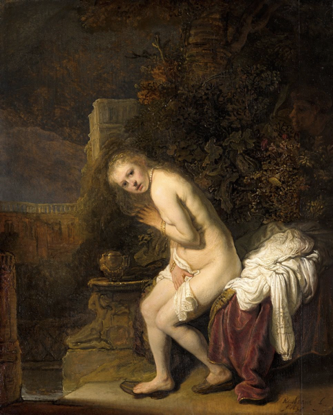 Rembrandt, Susanna and the Elders, 1636.
Rembrandt, Susanna and the Elders, 1636.
Where Susannah then directs her gaze relative to the viewer can further emphasize or exonerate his or her complicity. In both of Rembrandt’s depictions of the scene (fig. 4, 9), Susannah locks eyes with the viewer. Martha Hollander suggests that whoever is on the receiving end of such a gaze is “cast in the uncompromising — and titillating — role of voyeur.” She suggests that this does not appear to be a plea for help, but a sudden recognition of being seen, inappropriately, by the wrong people in the wrong condition. Based on this interpretation, it is clear that Reni’s Susannah implicates the Elders, as this paper’s analysis of the transformations of her gaze has already established. But the relationship between Susannah and the viewer remains unclear.
Alexander Kozin interprets the painting differently; he suggests that Susannah is making an appeal to a witness invisible in the painting. In the original text, Daniel performs the role of witness, and then reverses the direction of Susannah’s shame. Kozin identifies the viewer as this very witness — a substitute for Daniel, or perhaps even Daniel himself. It was his/our “ability to witness the injustice as the divine entity that gave Daniel-the-angel the possibility to demonstrate to the humans the power of justice [and] to give them truth in accordance with the circumstances of Susanna’s experience.”
The transformations we see in Reni’s Susannah and the Elders are active — the sudden emergence of the lecherous judges from their place of hiding, Susannah leaning away as she tries to make herself smaller, Susannah quickly pulling the linen to cover her body, forcing the leftmost Elder into action as he rushes to pull the fabric out from under her, the backmost Elder’s fingertips slowly landing upon Susannah’s hunched shoulder as she reaches to stop his accomplice — these transformations are currently taking place, in the moment, thereby allowing us to witness them, and thus, to intervene as Daniel. Although Susannah does not make eye contact with the viewer, her body faces away from the shadowy realm of the Elders, and toward us, illuminated by our (Daniel’s) divine light, prophesizing a near future in which we save this chaste heroine from death. In doing so, we render Susannah’s story arc a transformation in its own right, a cyclical sea change in which our innocent protagonist is pronounced guilty, then returned to innocence once more. The cruel Elders, for all their perversion and death threats, are discovered as bearers of false witness, and sentenced to death.
Let Wallace Stevens’s poem about Susannah pay tribute to Guido Reni, who honored this story of divine justice and its morals most faithfully. “Susanna’s music touched the bawdy strings/ Of those white elders; but, escaping,/Left only Death’s ironic scraping./Now, in its immortality, it plays/On the clear viol of her memory…”
Bibliography
Berger, John. Ways of Seeing. New York: Penguin Press, 1990.
Clark, Anthony M. “A Late, Great Guido Reni.” The Art Institute of Chicago Quarterly 54, no. 2 (April 1960): 3–7.
Fried, Michael. Notes towards a Caravaggisti Pictorial Poetics.” In Caravaggio and His Followers in Rome, edited by David Franklin and Sebastian Schutze, 102–123. New Haven: Yale University Press, 2011).
Garrard, Mary D. “Artemisia and Susanna.” In Artemisia Gentileschi: The Image of the Female Hero in Italian Baroque Art, 147–171. Princeton: Princeton University Press, 1991.
Hahn, Robert. “Caught in the Act: Looking at Tintoretto’s Susanna.” The Massachusetts Review 45, no. 4 (Winter 2004/2005): 633–647.
Hollander, Martha. “Losses of Face: Rembrandt, Masaccio, and the Drama of Shame.” Social Research 70, no. 4 (January 2003): 1327–50.
Kozin, Alexander. “‘Susanna and the Elders’: On the visual semiotic of shame.” Semiotica 216, (January 2017): 201–224.
Olszewski, Edward J. “Expanding the Litany for Susanna and the Elders.” Source: Notes in the History of Art 26, no. 3 (Spring 2007): 42–48.
Spear, Richard E. “Reni, Guido.” Oxford Art Online. Accessed January 1, 2020. https://www.oxfordartonline.com/groveart/view/10.1093/gao/9781884446054.001.0001/oao-9781884446054-e-7000071466#oao-9781884446054-e-7000071466
The National Gallery, London. “Two Biblical Scenes from Palazzo Lancellotti.” Accessed December 23, 2019. https://www.nationalgallery.org.uk/paintings/guido-reni-susannah-and-the-elders
Per i curiosi:
In Babilonia nel VI secolo a.C., due anziani considerati giudici saggi si innamorano della giovane e bella moglie di un certo Ioakìm. Dopo averla seguita per un certo tempo, si rendono conto come la donna sia solita passeggiare nel giardino del marito ad una data ora. Susanna viene quindi sorpresa sola dai due che le propongono un patto: può cedere a entrambi, oppure questi la denunceranno per adulterio dicendo di averla trovata con un amante, che non siano riusciti a catturare.
| « Susanna, piangendo, esclamò: «Sono alle strette da ogni parte. Se cedo, è la morte per me; se rifiuto, non potrò scampare dalle vostre mani. Meglio però per me cadere innocente nelle vostre mani che peccare davanti al Signore!. » (Daniele 13,22-23) |
Al momento del giudizio della donna, però, il giovane Daniele si proclama innocente del suo sangue, accusando la gente di esecuzione sommaria ai danni di una donna innocente. La folla si ferma, colpita da quanto il ragazzo dice e insospettita che Susanna possa essersi dimostrata tanto diversa dall'apparenza.
| « Tutti si voltarono verso di lui dicendo: «Che vuoi dire con le tue parole?». Allora Daniele, stando in mezzo a loro, disse: «Siete così stolti, Israeliti? Avete condannato a morte una figlia d'Israele senza indagare la verità! Tornate al tribunale, perché costoro hanno deposto il falso contro di lei». Il popolo tornò subito indietro e gli anziani dissero a Daniele: «Vieni, siedi in mezzo a noi e facci da maestro, poiché Dio ti ha dato il dono dell'anzianità». » (Daniele 13,48-50) |
Daniele procede quindi ad interrogare i due anziani separatamente, dimostrando la loro colpevolezza grazie alle loro contraddizioni e accusandoli di avere più volte abusato di vittime innocenti.
| « Così facevate con le donne d'Israele ed esse per paura si univano a voi. Ma una figlia di Giuda non ha potuto sopportare la vostra iniquità. » (Daniele 13,57) |
I due vecchi vengono quindi giustiziati, mentre Susanna torna libera e salva da suo marito e dai suoi genitori.
La storia è ripresa nell'Antico Testamento di Susanna, ed il soggetto fu non poco aprezzato da molti pittori tra l'inizio del 1500 e la fine del 1700. Significative le opere di Artemisia Gentileschi che nel 16oo affrontò più volte l'argomento.
Artemisia Gentileschi
- Susanna e i vecchioni (1610), conservato a Pommersfelden (Germania)
- Susanna e i vecchioni (1611),conservato a Stamford (Regno Unito)
- Susanna e i vecchioni (1649),conservato a Brno (Repubblica Ceca)
Altri artisti
- Susanna e i vecchioni, di Bernardino Luini (1515-1516 circa)
- Susanna e i vecchioni, di Lorenzo Lotto (1517),conservato a Firenze (Italia), Uffizi
- Susanna e i vecchioni, del Tintoretto (1560),conservato a Vienna (Austria)
- Susanna e i vecchioni, di Alessandro Allori (1561),conservato a Digione (Francia)
- Susanna e i vecchioni, di Paolo Veronese (circa 1580),conservato a Genova (Italia), Palazzo Bianco
- Susanna e i vecchioni, di Pieter Paul Rubens (1607),conservato a Roma (Italia)
- Susanna e i vecchioni, di Pieter Paul Rubens,conservato alla Reggia di Venaria Reale, Torino (Italia)
- Susanna e i vecchioni, di Jusepe de Ribera (1610-1612),conservato a Madrid (Spagna)
- Susanna e i vecchioni, di Guido Reni (1620),conservato a Londra (Gran Bretagna)
- Susanna e i vecchioni, di Giovan Francesco Barbieri, detto il Guercino (1650),conservato a Parma (Italia)
- Susanna e i vecchioni, di Mattia Preti (1656-1659),conservato a Pistoia (Italia)
- Susanna e i vecchioni, di Giovanni Battista Pittoni (1687-1767) conservato al Metropolitan Museum of Art di New York
- Susanna e i vecchioni, di Luca Giordano (1684-1685),conservato a Novara (Italia)
- Susanna e i vecchioni, di Jean-François de Troy (1727),conservato a Rouen (Francia)
- Susanna e i vecchioni, di Pompeo Batoni (1708-1787)




